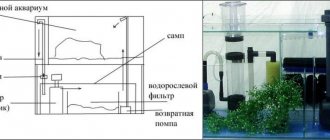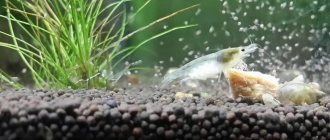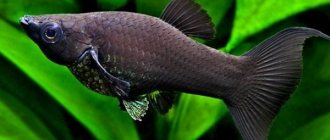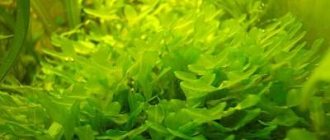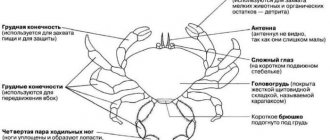Piranhas in the aquarium
Common name: Pygocentrus nattereri.
Kingdom: Animals.
Type: Chordata.
Class: Ray-finned fish.
Order: Characiniformes.
Family: Piranha (contains 16 modern genera with 97 species).
International scientific name: Serrasalmidae Bleeker, 1859.
Maximum size: From 10 to 14 cm, some types up to 30 cm.
Lifespan: 4-25 years.
Habitat: Amazon and Paraguay rivers.
Water parameters for keeping piranhas: pH from 7.0 to 7.5.
Temperature: 24.5 to 28.4 C.
Minimum aquarium volume: From 120 liters.
Food: Omnivores.
Despite their reputation as a dangerous tropical fish, piranhas are quite popular aquarium fish.
Next, we recommend that you watch an excellent visualization of these fish, which are actually not so aggressive.
Piranha habitat
Piranha habitat
Piranha habitat
Piranha habitat
Piranhas are a family of freshwater fish from the order Characinidae, living in the waters of South America (Argentina, Bolivia, Brazil, Venezuela, Colombia, Paraguay, Peru, Uruguay, Ecuador, etc.), in the rivers of the Amazon, Parana, Uruguay, Essequibo, and Orinoco basins. Piranhas feel equally good both in rivers and in channels and floodplain lakes.
Difficult character
It is still not recommended for beginners to have cougars. In a number of situations (for example, when transferred), it can injure its owners. If there is a need to transport it, you need to use a special net made of soft wire or thick twine.
When the fish is well-fed, you can go into its habitat. But only if there are no unhealed cuts or at least a drop of blood on them. Otherwise, the beauty will show that it’s not for nothing that many are afraid of her.
Therefore, letting small children and curious cats get close is also dangerous.
In general, their temperament is contradictory - both aggressive (although not as much as in their native element) and timid. From loud sounds and sudden movements, the piranha even briefly loses consciousness.
Appearance of piranhas - description
Piranha appearance
The piranha family is one of the extremely aggressive freshwater fish. They have two rows of sharp, triangular teeth that are tightly packed on both sides of the jaw. The anal and dorsal fins are long, the pelvic fins are short. The eyes are large, the pupils are dark. The jaws have very sharp teeth, set like teeth on a saw, which close together without gaps when bitten.
Piranha photo
Female piranhas are larger and thicker than males. Males have brighter colors.
Piranhas are typically colored in shades of red, blue, green, brown, silver or black.
The lifespan of Piranhas is from four to twenty-five years, depending on the species and conditions of detention (larger ones live longer).
Purchase and how much it costs
When buying fish, make sure that the piranhas are healthy: active, not injured, without impaired coordination of movements. You can buy them via the Internet and from a breeder, in a specialized store (preferably), or from the owner for whom they did not suit for some reason.
When buying fish, make sure that the piranhas are healthy: active, not injured
Depending on the type and size, piranhas cost from 500 to 3000 rubles.
Redfin mili (Myloplus rubripinnis), Müller & Troschel, 1844.
Redfin mili photo
This species of piranha has a silver-gray color and a reddish anal fin. There are fish with a reddish belly and red-gold spots on the body. The anal fin of the male has a long outer braid and a notch.
Synonyms: stellate mileus.
Body length: from 10 to 25 cm, in aquariums rarely exceeds 15 cm.
Water parameters: t from 22 to 27 0C, dKH < 1°, dGH up to 5°, pH from 6.5 to 7.0.
Food: omnivore.
Habitat: rivers of Guyana, Suriname and Amazon.
Compatibility
It is allowed to add other aquarium species to piranhas. Good compatibility will be observed if you add:
- guppy;
- neon;
- swordtails;
- minors
You can't put a goldfish next door. Predators will mistake it for food.
Red pacu (Piaractus brachypomus), Cuvier, 1818.
Red pacu photo
The main body color of the red pacu is silver. The underbelly and fins are colored red. A dark stripe runs along the edge of the caudal fin.
In nature, the main diet consists of nuts. To keep a red pacu, you need an aquarium with a volume of at least 200 liters.
Synonyms: red-breasted pacu, two-toothed colossoma, Colossoma bidens.
Body length: up to 80 cm, in aquariums does not exceed 50 cm.
Water parameters: t from 26 to 30 0C, dKH < 2°, dGH up to 14°, pH from 6.0 to 7.2.
Food: omnivore, but eats almost no meat.
Life expectancy: up to 28 years.
Habitat: Amazon river basin.
Brown pacu (Colossoma macropomum), Cuvier, 1816.
Brown pacu photo
A type of piranha with a brown, gray or black body color. The appearance of fish of this species resembles piranhas, the body is high, laterally compressed, and the eyes are large. About 10% of body weight is fat. The fish has square teeth, making them incredibly similar to human teeth. Instead of piercing the prey with its fangs and tearing it apart, the pacu bites right through the body of the prey, tearing off pieces of the body. The fish can easily crack nuts with its jaws.
Brown pacu, as a rule, are solitary; juveniles consume zooplankton, insects, and snails; adult fish are mainly herbivorous. Young individuals stay in the black waters of the river until puberty. Brown pacu is common in aquaculture, has good immunity and tolerates low water salinity.
Synonyms: Tambaki.
Body length: up to 70 cm, there are individuals over 100 cm.
Weight: up to 40 kg.
Water parameters: t from 26 to 30 0C, dKH < 2°, dGH up to 14°, pH from 6.0 to 7.2.
Food: omnivore.
Life expectancy: from 20 to 25 years.
Habitat: Amazon and Orinoco river basins.
Flag Piranha (Catoprion Mento), Cuvier, 1819.
It has an oblong, laterally compressed body of a silvery color, with a green tint in the back area. The Flag Piranha has a small red spot near its gill covers. The fins are transparent. The first rays of the dorsal and anal fin are elongated. There is a small black spot at the base of the tail. Among the features one can highlight a rather massive lower jaw, which is characteristic of almost all types of Piranha.
The Flag Piranha is a predatory fish, so you should not keep it in a community aquarium, as smaller fish will be eaten, and larger species will most likely lose their scales and fins.
Synonyms: Pennant Piranha, Wimpel Piranha, Serrasalmus mento, Mylesinus macropterus.
Body length: up to 15 cm.
Water parameters: t from 22 to 25 0C, dKH < 1°, dGH up to 15°, pH from 5.5 to 7.5.
Food: omnivore.
Life expectancy: from 10 to 12 years.
Habitat: the Amazon, Orinoco, Essequibo river basins and the upper reaches of Paraguay.
What to feed
Feed the animals once a day. A portion of food should be eaten within a couple of minutes, then the piranha will not overeat, and the water will not be contaminated with uneaten food. Provide food commensurate with the jaws of the fish; the piranha ignores food that is too small. Piranhas differ greatly in the type of food they eat. However, occasionally predators need plant nutrition, just as vegetarians sometimes need variety in the form of live food.
Predatory
Feed carnivorous piranha species:
Once a week, give predators a fasting day. Make sure that all the inhabitants of the aquarium are well-fed, because in case of malnutrition, mutual oppression or eating of other species will begin. Serve mammalian meat as a supplement to the diet, do not abuse it.
Herbivores
Unlike carnivorous species, herbivores accept dry food. The basis of the diet are:
Feed with tubifex and bloodworms. Animal feed should not exceed 20% of the diet.
Metynnis luna, Cope, 1878.
Lunar Metinnis photo
Representatives of this species are very tall-bodied, silvery with a reddish spot behind the gill cover. The anal fin is veiled in males, reddish in females. They mature at 1.5 years. Metinnis are herbivorous fish that can damage or completely destroy plants. They enjoy eating cabbage and lettuce leaves.
Body length: up to 25 cm.
Water parameters: t from 26 to 28 0C, dKH < 1°, dGH up to 15°, pH from 5.0 to 6.8.
Food: omnivore.
Habitat: Amazon river basin.
Slender piranha (Serrasalmus elongates), Kner, 1858.
Slender piranha photo
The body of the Slender Piranha is silver-gray with small pockmarks and a wide black border at the root of the tail. Very aggressive looking. Having reached sizes from 1.5 to 2 cm, young fish can begin to attack each other, causing injury.
The fish got its name because of its elongated body shape. In community aquariums, it can bite the fins of slow-moving fish, so they are kept with active large fish, and preferably a school in a species aquarium.
Synonyms: Serrasalmus elongatus.
Body length: maximum up to 30 cm.
Water parameters: t from 26 to 28 0C, dKH < 2°, dGH up to 14°, pH from 6.2 to 7.2.
Food: omnivore.
Habitat: Amazon and Orinoco river basins.
Natterer's piranha (Pygocentrus nattereri), Kner, 1858.
Piranha Natterera photo
Also known as "saikanga". This variety of Piranha received its name in honor of the Austrian scientist Johann Natterer. Juveniles of this species have a very bright bluish body color. The chest and paired fins are red, the caudal fin is black with a wide blue vertical stripe. The back is dark in color. After 8 months, the fish changes color and becomes gray-silver, the sides turn pink, the spots fade or disappear altogether, but small golden sparkles appear. The anal fin becomes lighter, and with the onset of spawning it becomes completely red. During this period, the length of the Piranha should exceed 8 cm. The upper row of teeth is smaller than the lower one. Female Natterer's Piranhas are slightly larger and thicker than males. The keel of the male's abdomen from the front looks like the Latin letter V, and in females it looks like a U. The shape of the anal fin of the male is pointed, while that of the female is rounded.
Synonyms: Common piranha.
Body length: maximum up to 60 cm, usually up to 35 cm.
Water parameters: t from 26 to 28 0C, dKH < 2°, dGH up to 14°, pH from 6.2 to 7.2.
Food: omnivore.
Habitat: rivers of Brazil, Argentina, Colombia, Venezuela, Paraguay, Guyana.
Red-bellied
The name of this fish translated from the language of the Amazonian aborigines means “evil fish.”
It received its Latin name (Pygocentrus nattereri) in honor of I. Naterrera, a scientist from Austria.
Piranhas are dangerous predators. When they are hungry, they leave no chance for their victims to survive.
Red-bellied piranhas are timid. They prefer to move away from danger.
During severe drought and during the spawning season, they become noticeably more aggressive.
During the rainy season, local residents go into the water without fear.
Metynnis argenteus, Ahl, 1923.
Metinnis silver photo
A small variety of Piranha. It has a silver-gray body color with chaotically scattered dark warts. The anal fin of the male is veiled, while that of the female is straight and reddish.
Synonyms: silver dollar fish.
Body length: from 10 to 14 cm.
Water parameters: t from 22 to 27 0C, dKH < 1°, dGH up to 5°, pH from 6.5 to 7.0.
Food: omnivore.
Habitat: rivers of the Orinoco and Amazon basins.
Common Metynnis (Metynnis hypsauchen) Müller Troschel.
A small variety of piranha. It has a silver body color with a white belly and transparent fins. The back of Metinnison vulgaris can have a grayish-blue, brown or green tint. The scales have a blue, yellow or greenish tint. The end of the anal fin is red. The body of the fish is high and round, strongly flattened on the sides. There may be black transverse stripes and spots along the sides.
Genera and species of the piranha family in alphabetical order:
Show/Hide text
Acnodon (Eigenmann, 1903): Acnodon normani (Gosline, 1951), Acnodon oligacanthus (Müller & Troschel, 1844), Acnodon senai (Jégu & Santos, 1990).
Catoprion (Müller et Troschel, 1844): Catoprion mento (Cuvier, 1819), Colossoma (Eigenmann et Kennedy, 1903), Colossoma macropomum (Cuvier, 1816).
Metynnis (Cope, 1878): Metynnis altidorsalis (Ahl, 1923), Metynnis argenteus (Ahl, 1923), Metynnis cuiaba (Pavanelli, Ota & Petry, 2009), Metynnis fasciatus (Ahl, 1931), Metynnis guaporensis (Eigenmann, 1915) , Metynnis hypsauchen (Müller & Troschel, 1844), Metynnis lippincottianus (Cope, 1870), Metynnis longipinnis (Zarske & Géry, 2008), Metynnis luna (Cope, 1878), Metynnis maculatus (Kner, 1858), Metynnis mola (Eigenmann & Kennedy, 1903), Metynnis orinocensis (Steindachner, 1908), Metynnis otuquensis (Ahl, 1923), Metynnis polystictus (Zarske & Géry, 2008).
Piranha photo
Mylesinus (Cuvier et Valenciennes, 1849): Mylesinus paraschomburgkii (Jégu, Santos & Ferreira, 1989), Mylesinus paucisquamatus (Jégu & Santos, 1988), Mylesinus schomburgkii (Valenciennes, 1850).
Myleus (Müller et Troschel, 1844): Myleus altipinnis (Valenciennes, 1850), Myleus knerii (Steindachner, 1881), Myleus latus (Jardine, 1841), Myleus micans (Lütken, 1875), Myleus pacu (Jardine, 1841), Myleus setiger (Müller & Troschel, 1844).
Myloplus (Gill, 1896): Myloplus arnoldi (Ahl, 1936), Myloplus asterias (Müller & Troschel, 1844), Myloplus laevis (Eigenmann & McAtee, 1907), Myloplus lobatus (Valenciennes, 1850), Myloplus lucienae (Andrade, Ota, Bastos & Jégu, 2016), Myloplus planquettei (Jégu, Keith & Le Bail, 2003), Myloplus rhomboidalis (Cuvier, 1818), Myloplus rubripinnis (Müller & Troschel, 1844), Myloplus schomburgkii (Jardine, 1841), Myloplus ternetzi (Norman , 1929), Myloplus tiete (Eigenmann & Norris, 1900), Myloplus torquatus (Kner, 1858), Myloplus zorroi (Andrade, Jégu & Giarrizzo, 2016).
Piranha photo
Mylossoma (Eigenmann et Kennedy, 1903): Mylossoma acanthogaster (Valenciennes, 1850), Mylossoma aureum (Spix & Agassiz, 1829), Mylossoma duriventre (Cuvier, 1818).
Ossubtus (Jégu, 1992): Ossubtus xinguense (Jégu, 1992).
Piaractus (Eigenmann, 1903): Piaractus brachypomus (Cuvier, 1818), Piaractus mesopotamicus (Holmberg, 1887).
Pristobrycon (Eigenmann, 1915): Pristobrycon aureus (Spix & Agassiz, 1829), Pristobrycon calmoni (Steindachner, 1908), Pristobrycon careospinus (Fink & Machado-Allison, 1992), Pristobrycon maculipinnis (Fink & Machado-Allison, 1992), Pristobrycon striolatus (Steindachner, 1908).
Piranha teeth mouth photo
Pygocentrus (Müller et Troschel, 1844): Pygocentrus cariba (Humboldt, 1821), Pygocentrus nattereri (Kner, 1858), Pygocentrus palometa (Valenciennes, 1850), Pygocentrus piraya (Cuvier, 1819).
Pygopristis (JP Müller & Troschel, 1844): Pygopristis denticulata (Cuvier, 1819).
Piranha photo
Serrasalmus (Lacepède, 1803): Serrasalmus altispinis (Merckx, Jégu & Santos, 2000), Serrasalmus Altuvei (Ramírez, 1965), Serrasalmus auriventris (Burmeister, 1861), SERRASALMUS Branmus Bran DTII (Lütken, 1875), Serrasalmus Compressus (Jégu, Lege & Santos, 1991), Serrasalmus eigenmanni (Norman, 1929), Serrasalmus elongatus (Kner, 1858), Serrasalmus emarginatus (Jardine, 1841), Serrasalmus geryi (Jégu & Santos, 1988), Serrasalmus gibbus (Castelnau, 1855), Serrasalmus gouldingi ( Fink & Machado-Allison, 1992), Serrasalmus hastatus (Fink & Machado-Allison, 2001), Serrasalmus hollandi (Eigenmann, 1915), Serrasalmus humeralis (Valenciennes, 1850), Serrasalmus irritans (Peters, 1877), Serrasalmus maculatus (Kner, 1858), Serrasalmus manueli (Fernández-Yépez & Ramírez, 1967), Serrasalmus marginatus (Valenciennes, 1837), Serrasalmus medinai (Ramírez, 1965), Serrasalmus nalseni (Fernández-Yépez, 1969), Serrasalmus neveriensis (Machado-Allison, Fink , López Rojas & Rodenas, 1993), Serrasalmus nigricans (Spix & Agassiz, 1829), Serrasalmus nigricauda (Burmeister, 1861), Serrasalmus odyssei (Hubert & Renno, 2010), Serrasalmus rhombeus (Linnaeus, 1766), Serrasalmus sanchezi (Géry, 1966) 4 ), Serrasalmus scotopterus (Jardine, 1841), Serrasalmus serrulatus (Valenciennes, 1850), Serrasalmus spilopleura (Kner, 1858), Serrasalmus stagnatilis (Jardine, 1841), Serrasalmus undulatus (Jardine, 1841).
Tometes (Cuvier et Valenciennes, 1849): Tometes ancylorhynchus (Andrade, Jégu & Giarrizzo, 2016), Tometes camunani (Andrade, Giarrizzo & Jégu, 2013), Tometes kranponhah (Andrade, Jégu & Giarrizzo, 2016), Tometes lebaili (Jégu, Keith & Belmont-Jégu, 2002), Tometes makue (Jégu, Santos & Belmont-Jégu, 2002), Tometes trilobatus (Valenciennes, 1850).
Utiaritichthys (Miranda Ribeiro, 1937): Utiaritichthys esguiceroi (Pereira & Castro, 2014), Utiaritichthys longidorsalis (Jégu, Tito de Morais & Santos, 1992), Utiaritichthys sennaebragai (Miranda Ribeiro, 1937)
Piranha content
Piranha content
Water parameters for keeping piranhas: temperature from 22 to 27 C, dKH < 1, dGH up to 5, pH from 6.5 to 7.0.
Piranhas are large schooling fish with a body length of 10 cm. As a result, to comfortably maintain a school, you will need an aquarium with the calculation: 8 liters per 2.5 cm of adult fish. Consequently, you will have to purchase an aquarium of 120 liters or more (preferably more - 250-500 liters +++). Piranhas are schooling fish, so they should be kept in groups of at least four individuals.
When keeping piranhas in small aquariums, the fish show nervousness and aggression towards their fellows.
Piranha
Comfortable temperature is from 24.5 C to 28.4 C. Higher temperatures can cause breathing problems, while lower temperatures lead to illness and death of fish. To prevent such situations, some aquarists use two heaters to prevent malfunctions and prevent temperature drops.
Keeping piranhas at high temperatures leads to a decrease in oxygen in the water, the lack of which can lead to diseases of the fish’s heart system and a weakening of its immunity. A weak immune system causes a number of diseases. Therefore, the presence of aeration in your aquarium is mandatory.
Wild specimens are kept in soft water, which is not very convenient; therefore, specimens bred in captivity, which are more resilient and thrive in water with a pH of 7.5+, are more popular among aquarists.
Piranha photo
The most important thing is that there are no excessive concentrations of nitrogen compounds and phosphates . This is the main problem for fish that beginners make. Ammonia, nitrite, nitrate, phosphates are the root cause of illness and death in pets. Every conscientious aquarist should always have a set of drop tests on hand, at least for nitrate and phosphate. Fortunately, they have now become inexpensive, there are no problems with their assortment and acquisition. For example, we can with a clear conscience recommend you the cool UHE drop tests, , but they are sold only online. In stores in your city - offline, you can find inexpensive Vladox tests .
It would be useful to use Tetra EasyBalance , fish produce large amounts of phosphates and nitrogen to be healthy. High-quality water, preparations that remove excess nitrogen and phosphorus are our everything.
Piranha content
Piranhas are photosensitive fish and may experience discomfort in strong light as their large pupils are unable to contract to reduce light. Therefore, it is necessary to use dim lighting, or use floating or long-stemmed plants to filter the light. It is also worth abandoning the cultivation of light-loving plants.
In addition to plants, the aquarium must have a sufficient number of shelters.
As fish mature, they become more aggressive and territorial.
Piranhas eat a lot and therefore produce a lot of waste. For this reason, it is important to have a good filtration system and perform weekly changes of 15–20% of the water in the aquarium. Great care must be taken when cleaning a piranha tank, as these “cute” fish can easily bite off a large piece of flesh in one bite.
Piranha photo
When choosing a filter, make sure that the filter is capable of providing sufficient filtration for a large aquarium. Some aquarists in piranha aquariums use several small filters to maintain cleanliness, this has a painless effect on the fish during routine filter cleanings.
Diseases
Piranhas are hardy and rarely get sick. In poor conditions they are susceptible to:
- poisoning;
- oodiniumosis;
- ichthyophthyriasis;
- “cotton wool disease”;
- tuberculosis.
Effective medications for most diseases can be purchased at a pet store. Before treating fish, read the instructions and determine the causes of the disease. Adjust the conditions: check the water for nitrates and other dangerous compounds, provide the piranhas with a balanced diet and make sure that the water parameters in the home aquarium are suitable for the fish.
Feeding piranhas in an aquarium
Feeding Piranhas in an Aquarium
Despite their reputation as bloodthirsty killers, these fish are actually omnivores. Balanced and varied food is the key to calm relationships in the aquarium. Therefore, the main food products for piranhas should be various high-quality fish products, which are abundant in fish markets today. In the wild, most piranhas feed on the fins and scales of other large fish, and also consume plant matter. You can add a small amount of fresh raw vegetables (zucchini, spinach, zucchini, raw potatoes) to your diet. Some frozen foods, such as chopped beef, are used as occasional food.
Piranha photo
The amount of food introduced must be eaten by the fish in two minutes (with the exception of fresh vegetables, which can be left for several hours). If food remains in the aquarium after this time, it can lead to a deterioration in water quality.
Piranhas only need to be fed once a day. More intensive feeding results in more waste produced by the fish and an increased risk of overfeeding. Providing proper nutrition increases the lifespan of your piranhas and strengthens their immune system.
As for branded foods, we recommend feeding piranhas with proven high-quality food, for example, Tetra Cichlid XL Sticks
It should be noted that when purchasing any dry food, you should pay attention to the date of its manufacture and shelf life, try not to buy food in bulk, and also store the food in a closed state - this will help to avoid the development of pathogenic flora in it.
Tips for an aquarist
All equipment should be purchased and tested in advance, and the aquarium should be started immediately before the piranhas are introduced.
During the first hours after moving in, you should not feed the fish or turn on the lighting or equipment - you need to give your pets time to get used to the new aquarium.
A metal net should be used to catch fish.
Cleaning the aquarium must be done carefully, without sudden movements.
Piranhas can jump out of the aquarium, so it is necessary to cover it with a lid. If the fish does jump onto the floor, you should not catch it with your hands - in a stressed state, it can bite strongly.
A lonely piranha in an aquarium can become depressed, refuse to eat and die. It is best to start a species aquarium with a flock of five to six piranhas of the same age and size.
Despite their aggressive behavior, piranhas are amazing and fascinating creatures that you can watch for hours. Thanks to their exoticism and unpretentiousness, many people fell in love with pets, and now an aquarium with piranhas is a fairly common occurrence. The main thing is not to forget to care for the fish and follow safety rules.
Would you dare to have piranhas in your aquarium? Why? Share your opinions in the comments.
Breeding piranhas
Breeding piranhas in an aquarium
Breeding piranhas at home is extremely difficult and requires an extremely large breeding aquarium of 200 to 300 liters. For successful spawning, high-quality nutrition and appropriate water parameters are necessary.
Piranhas reach sexual maturity at one and a half years. The place chosen for laying is fiercely defended by the pair.
Piranha photo
The female lays eggs at dawn, the male fertilizes them and remains to guard the clutch. Once the spawning is complete, the male will also begin to attack the female and she should be removed from the spawning tank immediately.
The size of piranha eggs is from 2 to 4 mm. The color ranges from transparent amber to yellow-green. At a time, the female can lay from 500 to 15,000 eggs. The incubation period lasts from 2 to 15 days.
Piranhas are beautiful fish. If you provide them with everything they need: space for swimming, clean water without nitrogen compounds, plenty of shelter, high-quality varied food, then they will reciprocate for a long time. Treat piranhas with respect and their menacing teeth will never pose a threat to you. And having an aquarium with such unique fish will always be one of the topics of conversation among your guests.
And the author of the article is Alexander Isakov
General characteristics
Piranhas gather in schools, which makes it easier to find food, and pose a real threat to living objects they encounter. After the attack, the victim is torn to pieces within a few minutes. Some species of piranhas are not predators. Approximately 60% of fish feed on food of plant origin.
The reputation of predatory inhabitants of water bodies is not always deserved. Fish attack only when they think they are in danger, can get caught in a trap, or when they feel hungry. At the same time, some countries (for example, Israel) prohibit the possession, trade, storage, and shelter of these fish. Such actions are considered illegal.
